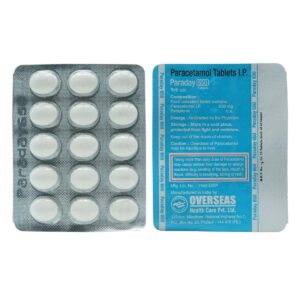PARACETAMOL (ACETAMENOPHEN) + METOCLOPRAMIDE
Paracetamol (acetamenophen): Paracetamol, also known as acetaminophen, is a commonly used over-the-counter medication for pain relief and fever reduction. It belongs to the class of drugs called analgesics (pain relievers) and antipyretics (fever reducers).
Paracetamol works by inhibiting the production of prostaglandins in the central nervous system, which are substances involved in pain and fever. By reducing prostaglandin levels, Paracetamol can help alleviate pain and lower fever.
The recommended dose of Paracetamol depends on the age, weight, and medical condition of the individual. For adults and children 12 years and older, the usual dose is 500-1000 mg every 4-6 hours, with a maximum daily dose of 4000 mg. For children aged 6-11 years, the dose is usually 250-500 mg every 4-6 hours, with a maximum daily dose of 2000 mg.
While Paracetamol is generally considered safe when used appropriately, it can have side effects, although they are rare. Some of the possible side effects include:
1. Gastrointestinal upset: Nausea, vomiting, and stomach pain may occur, especially at higher doses.
2. Allergic reactions: Some individuals may experience an allergic reaction, such as rash, itching, swelling, or difficulty breathing. It is important to seek medical attention if any signs of an allergic reaction occur.
3. Liver damage: Taking high doses of Paracetamol for an extended period or exceeding the recommended dose can lead to liver toxicity. It is crucial to adhere to the recommended dosages and seek medical advice if liver disease is present.
4. Blood disorders: Paracetamol can rarely cause blood disorders such as thrombocytopenia (decreased platelet count) and agranulocytosis (decreased white blood cell count).
5. Kidney problems: Prolonged high-dose use of Paracetamol may lead to kidney damage.
It is essential to follow the recommended dosage instructions and consult a healthcare professional if you have any underlying medical conditions or are unsure about the safe use of Paracetamol.
Metoclopramide: Metoclopramide is a medication that is primarily used to treat gastrointestinal disorders such as nausea, vomiting, and gastric stasis. It belongs to a class of drugs called prokinetic agents, which stimulate the movement of food through the stomach and intestines.
The mechanism of action of metoclopramide involves blocking dopamine receptors in the brain and the gut. By doing so, it increases the release of acetylcholine, a neurotransmitter that enhances the muscle contractions in the digestive tract and promotes the relaxation of the pyloric sphincter, allowing food to pass more easily from the stomach to the intestines.
Metoclopramide comes in various forms including tablets, oral solution, and injectable solution. The dosage and duration of treatment depend on the specific condition being treated. It is usually taken 30 minutes before meals and at bedtime. It is important to follow the recommended dosage and directions given by the healthcare provider.
Common side effects of metoclopramide include drowsiness, restlessness, fatigue, headache, and gastrointestinal symptoms such as diarrhea or constipation. Other less common side effects include involuntary muscle movements, tremors, and extrapyramidal symptoms, especially with high doses or prolonged use of the medication.
It is important to note that metoclopramide should not be used by individuals with a history of gastrointestinal bleeding, bowel obstruction, or seizures. It should also be used with caution in patients with Parkinson’s disease, as it may worsen their symptoms.
As with any medication, it is essential to discuss the potential risks and benefits of metoclopramide with your healthcare provider to determine if it is suitable for your specific condition and medical history.



